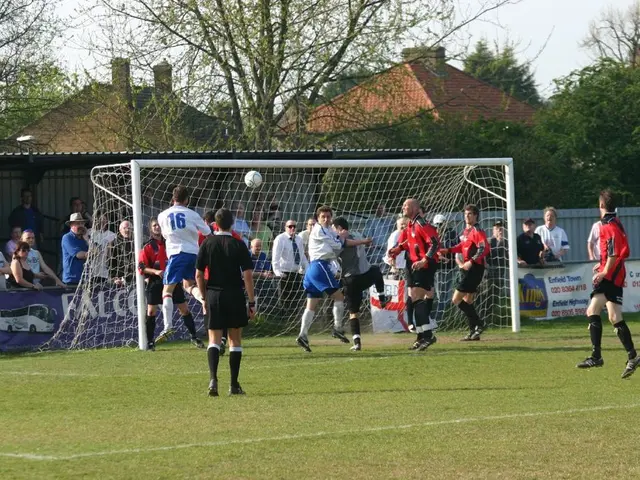Urgent appeal for measures to address football-induced brain injuries
Reimagined Article:
Concussions: A Hidden Danger for Young Athletes
Concussions and head injuries are alarmingly prevalent among young athletes in the United States. From 2002 to 2012, there was a staggering 200% surge in reported concussions in the 14-19 age group, and a comparable rise in emergency room visits for concussion among 8- to 13-year-olds.
In 2012 alone, about 325,000 teens visited emergency departments due to concussions - around 40 kids every hour.
A single blow to the head can be dangerous, but repeating these blows significantly ups the risk of long-term neurological issues and brain damage. Undiagnosed and untreated concussions and Traumatic Brain Injuries (TBIs) could potentially be fatal.
To combat this growing problem, the Centers for Disease Control and Prevention (CDC) launched the "Heads Up" initiative in 2003. Over a decade, they distributed over a million copies of their materials and trained over 1.5 million coaches online, raising awareness about TBIs and concussions.
Nevertheless, concerns persist.
What is Concussion?
Concussions occur from either a direct hit to the head or an indirect blow to the body. It affects how the brain functions, causing cognitive impairment, balance issues, memory lapses, and more. According to the American Association of Neurological Surgeons (AANS), a concussion is "A clinical syndrome characterized by an immediate and transient alteration in brain function, including alteration of mental status and level of consciousness, resulting from mechanical force or trauma."
Key figures:
- One third of concussions occur during practice, and around 20% of high school athletes will suffer a concussion during their sports season
- About one third of high school athletes who report a sports concussion will have at least one more within a year
- Nearly 5.3 million U.S. citizens live with a TBI-related disability
- Approximately 9 out of 10 concussions do not involve loss of consciousness
Understanding Concussion:
The brain is cushioned by cerebrospinal fluid within the skull, functioning similar to a shock absorber when a minor blow is received. In a concussion, the brain moves too quickly inside the skull and can collide with the skull's interior. This collision can result in damages to delicate neural pathways, leading to neurological issues like memory loss, judgment problems, reflex issues, speech difficulties, balance problems, and muscle coordination problems.
Hazards linked to concussions and TBIs include a higher risk of suicide and a dramatic increase in the risk of death from an unintentional injury, possibly due to cognitive and balance impairments.
Mouse Studies have suggested that young women who experience concussions may have a higher risk of alcohol abuse as adults.
Recovery from concussions is usually achievable without intervention, but a second concussion can increase the risk of permanent damage by a whopping 39 percent.
Concussion in Football
In the U.S., football leads the way in concussion incidents, with about 47 percent of sports concussions happening during high school football activities. Statistics indicate that the incidence of concussion in football is 64-76.8 per 100,000 participants, making it a colossal health concern.

Girls playing soccer are most at risk of concussions with 33 cases per 100,000, while cheerleaders have a rate of 11.5-14 per 100,000. In boy's ice hockey, the incidence is 54 per 100,000.
Considering the vast number of participants, Dr. Paul Auerbach, of Stanford University School of Medicine, likens the issue of concussions in football to a "colossally greater cause of significant injuries than boxing."
Signs and Symptoms of Concussion in Football Players
The CDC's "Heads Up" program lists key symptoms to recognize for coaches and players:
For players:
- Headache or pressure in the head
- Nausea or vomiting
- Balance problems or dizziness
- Double or blurry vision
- Sensitivity to light or noise
- Feeling sluggish, hazy, or distracted
- Memory and concentration problems
- Confusion
- Mood swings or feeling down
To others, the player may appear dazed or confused, forgetful, unsure of the game details, clumsy, slow to answer questions, or lose consciousness, even briefly.
When concussion is suspected, the CDC recommends:
- Removing the athlete from play
- Keeping them out of play for the rest of the day
- Obtaining clearance from a suitable healthcare professional before allowing the athlete to return to play.
Dr. Auerbach warns that athletes could feel normal in less than a week, but the injury may require at least 4-6 weeks to heal fully. Returning to play prematurely could lead to serious damage.
Return-to-Play Laws
Since 2009, "Return-to-Play" laws have been enacted in all 50 states and the District of Columbia to give athletes sufficient recovery time before exposing themselves to further risks.
The Washington law, also known as the Zackery Lystedt law, requires concussion guidelines, educational programs, annual concussion information sheets for parents and players, immediate removal from play upon suspicion, and written clearance from a specialized healthcare provider before returning to play.
While these laws are a positive step forward, Dr. Auerbach believes they do not go far enough. He calls for further action to prevent concussions in football. He proposes measures including:
- Eliminating "down linemen" in direct opposition at the line of scrimmage
- Banning tackling or intentional striking above the face mask
- Prohibiting forearm blows and "shivers" to the head
- Limiting full contact practice to two days a week with a maximum of 20 plays per player
- Suspending coaches who allow athletes with symptoms of concussion to play
- Implementing a gradual return-to-play protocol for athletes who have suffered a concussion.
Dr. Auerbach emphasizes that change is needed to safeguard the health of young athletes and prevent long-term brain injuries. While some radical changes may not be popular, he argues they could help make the sport safer and more agile. As more awareness grows about the dangers of concussions, both in the U.S. and internationally, the CDC calls for ongoing surveillance to effectively tackle the problem.
- The explosion in emergency room visits for concussions among young athletes, coupled with the rise in reported cases, underscores the need for increased awareness in the health-and-wellness sphere, particularly in sports like football and soccer where the risk of these injuries is high.
- A concern for mental health arises as mouse studies suggest that young women who experience concussions may have a higher propensity towards alcohol abuse as adults, demonstrating the far-reaching implications of these injuries beyond the physical realm.
- In the realm of science, understanding the mechanics of concussions could lead to breakthroughs in preventing and treating these injuries, promoting advancements in fitness-and-exercise routines, as well as in the field of sports medicine to ensure the safety and long-term wellbeing of young athletes.









